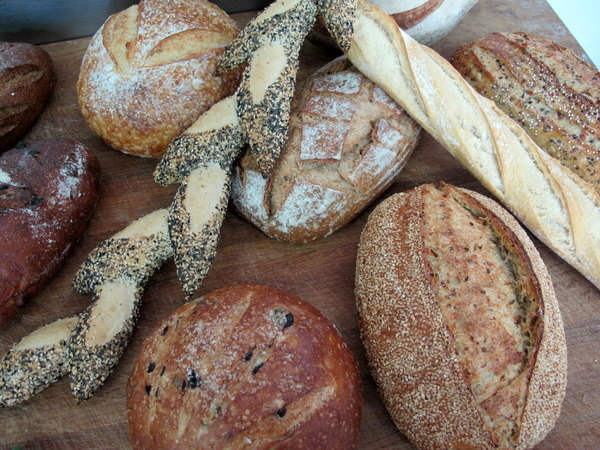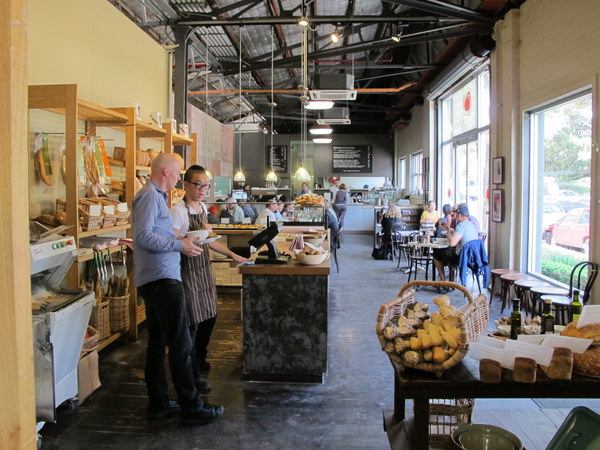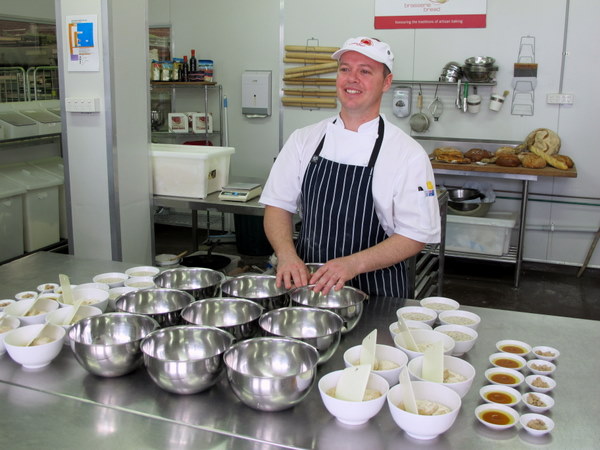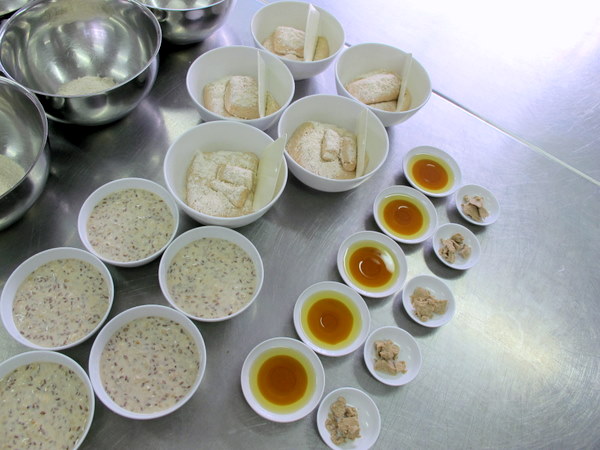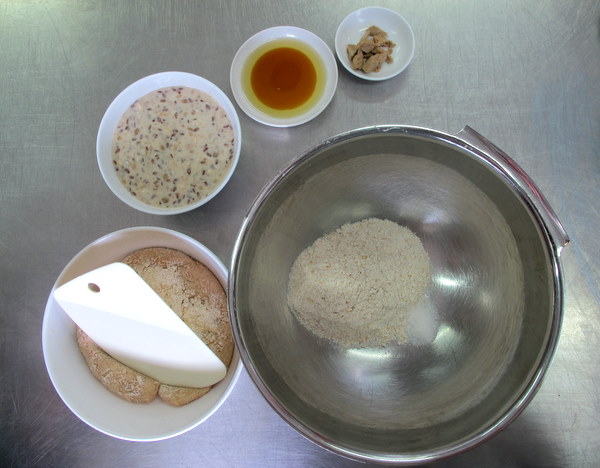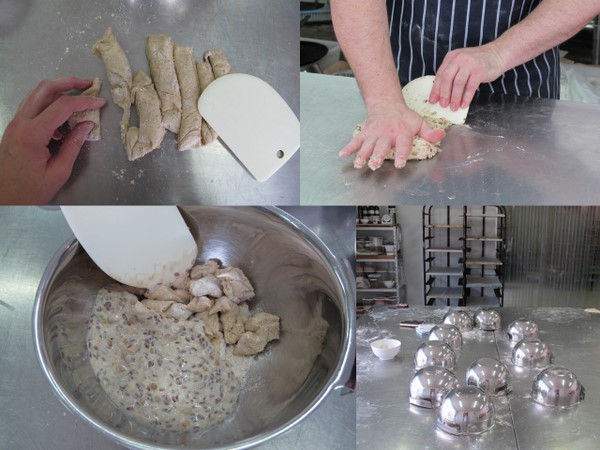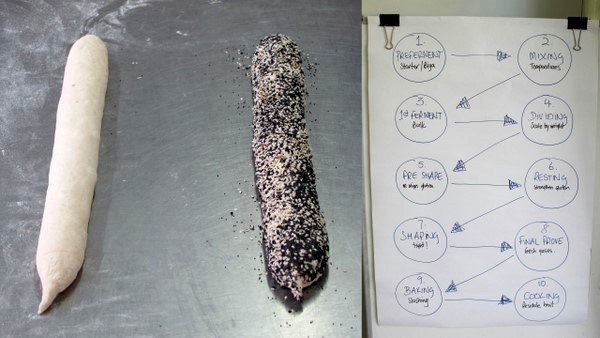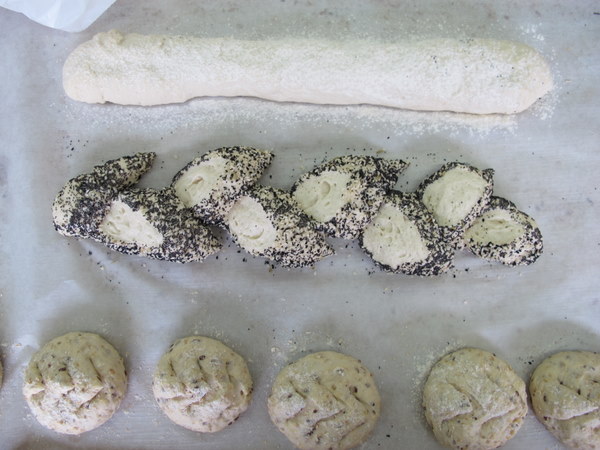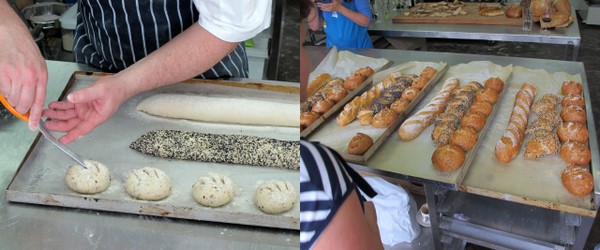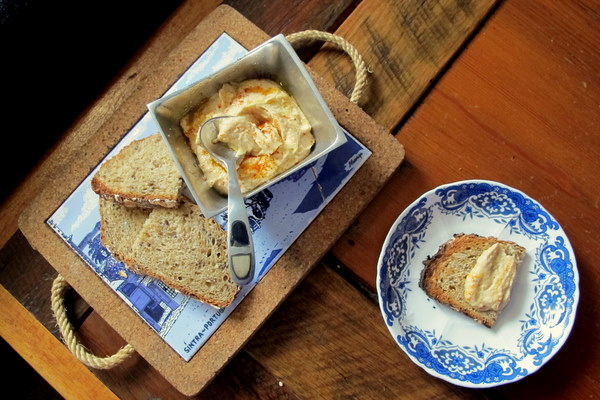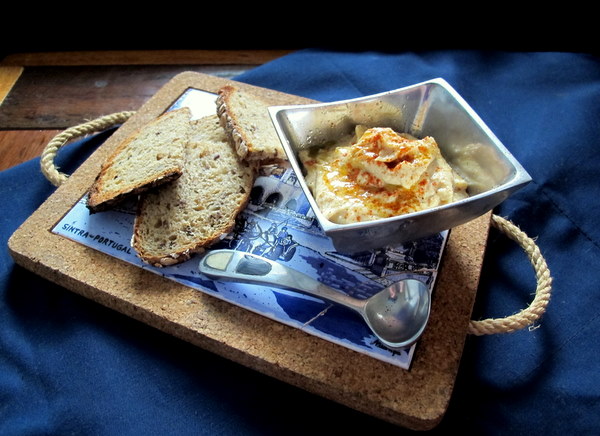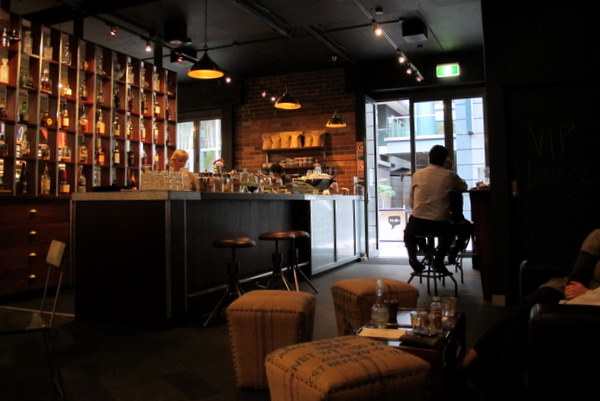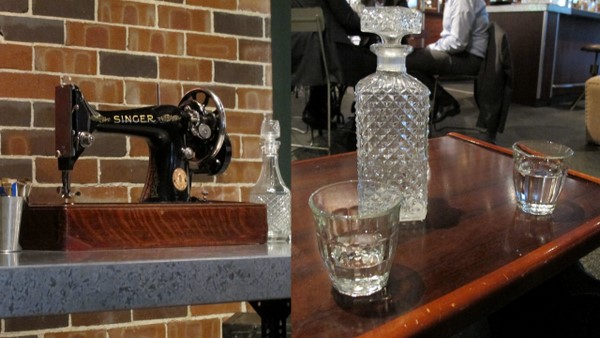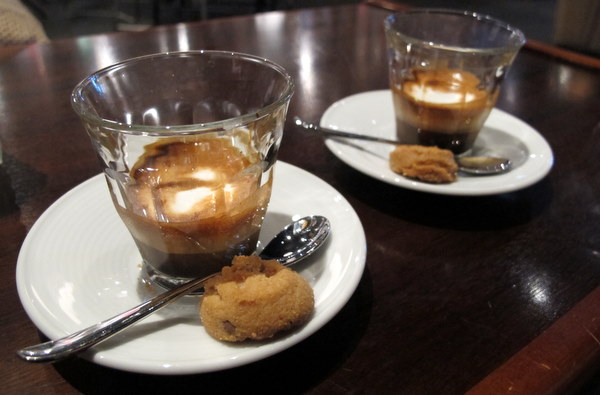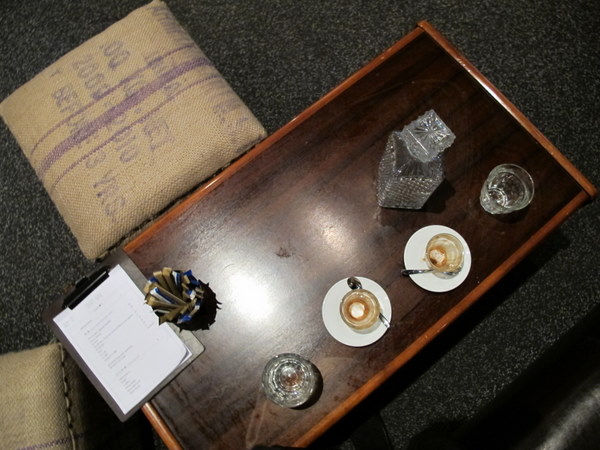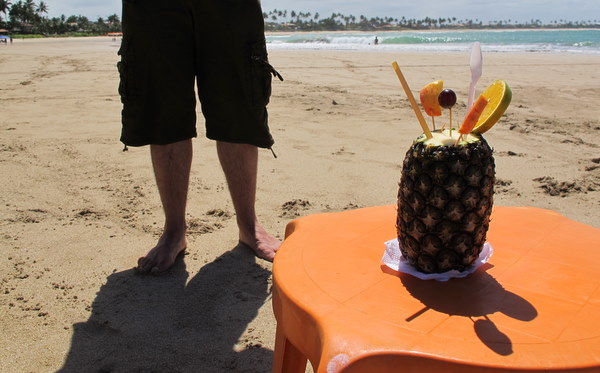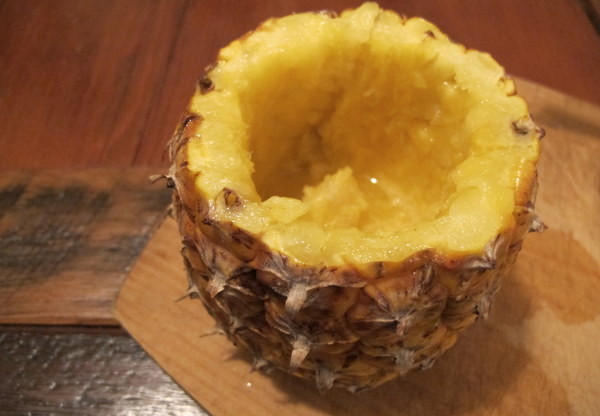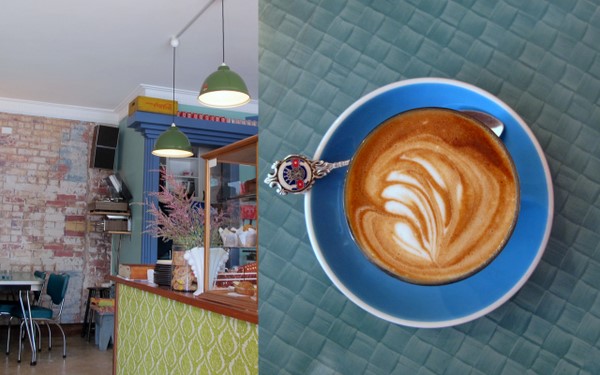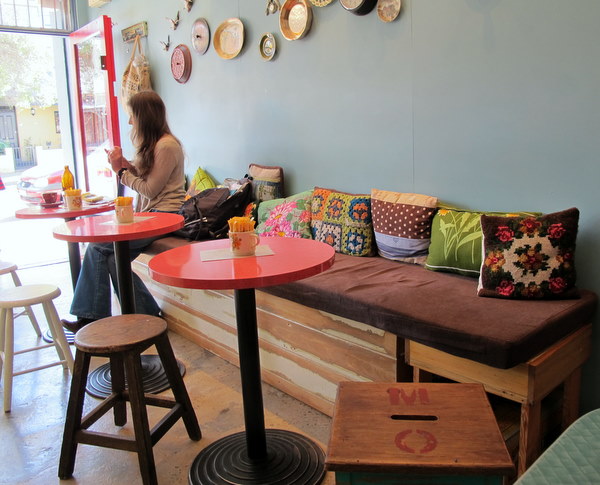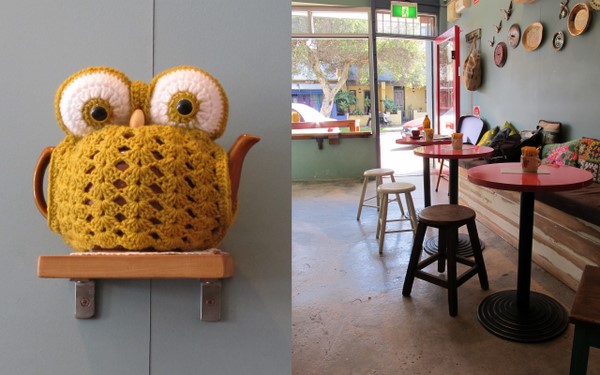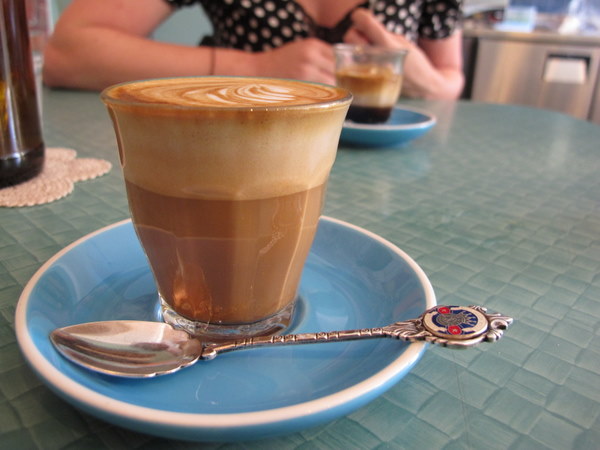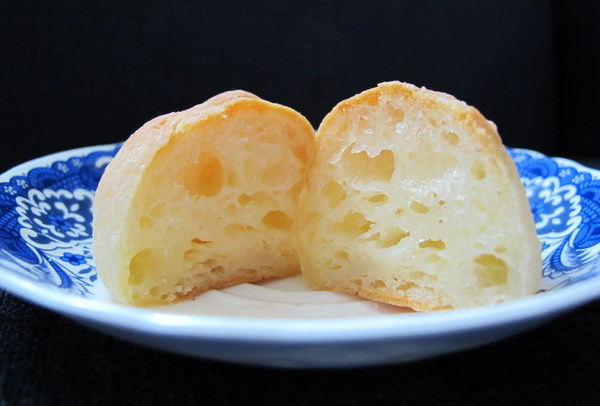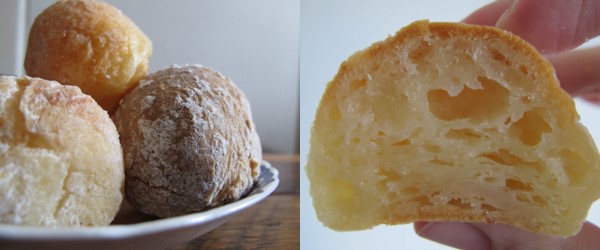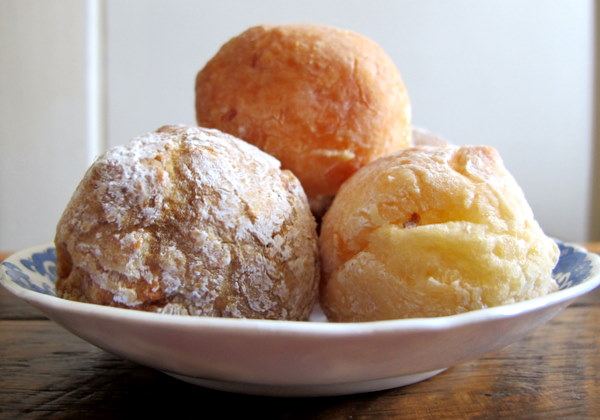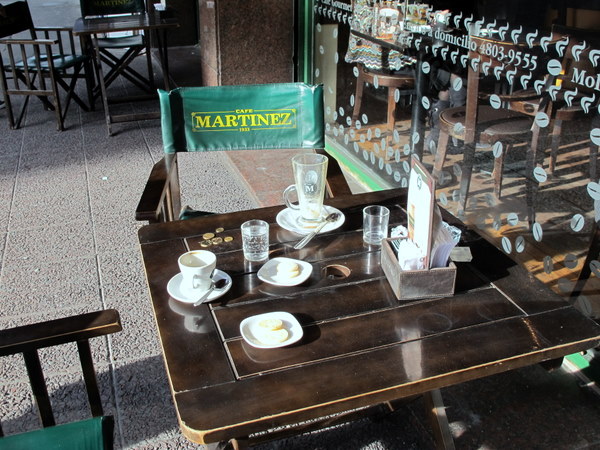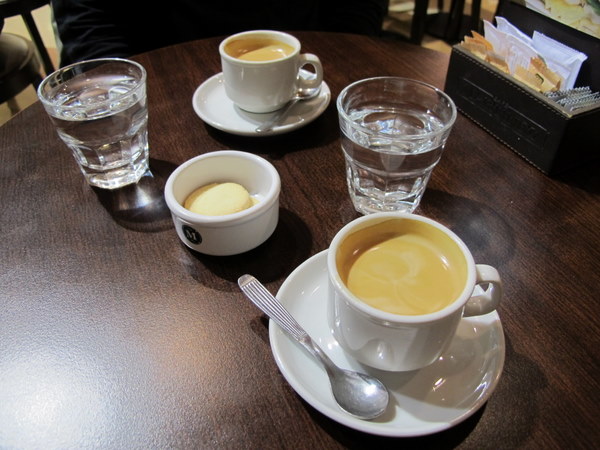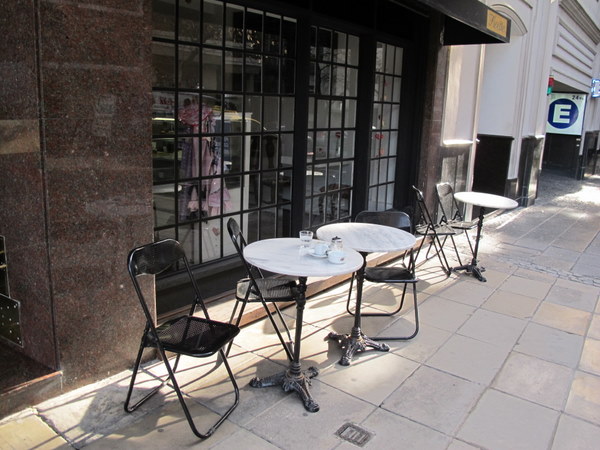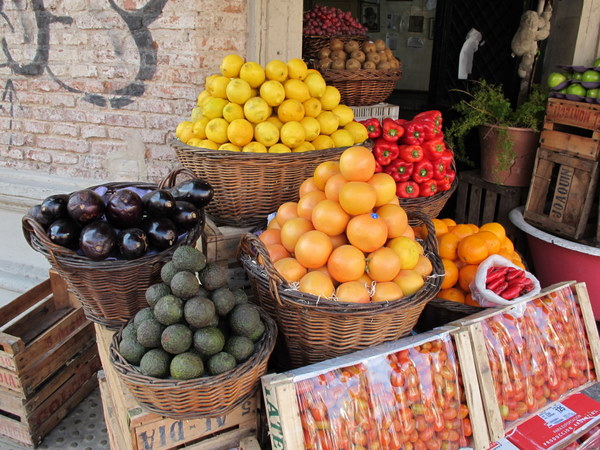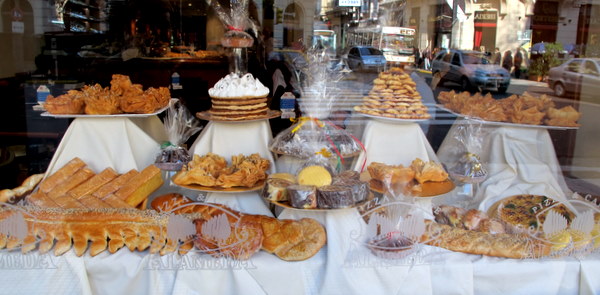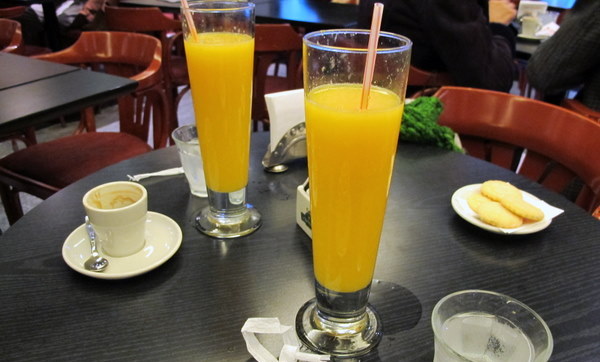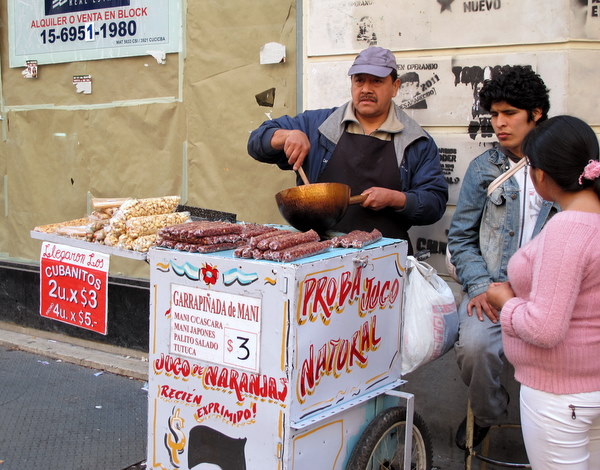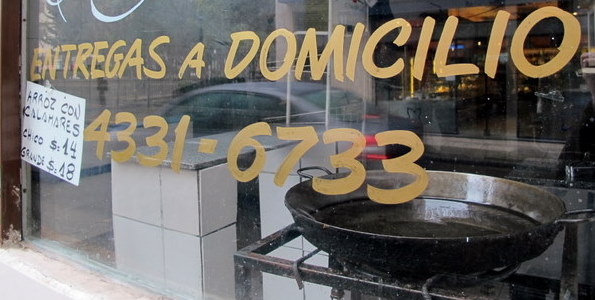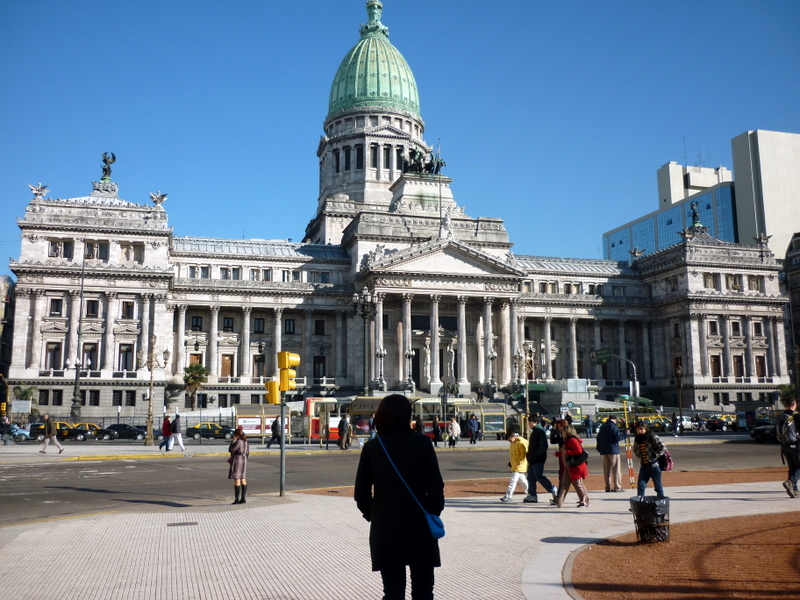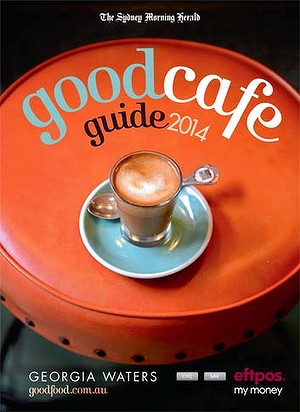A couple of weeks ago, I was lucky enough to be invited to a bread making workshop as Brasserie Bread in Banksmeadow. Silly me, I got Banksmeadow mixed up with Beaconsfield and so I found myself on a bus down Botany road at 10:35am, starting to panic. It’s a long way to Banksmeadow and I’ve learnt my lesson for next time.
Of course I needn’t have worried, as I entered the post-industrial café and through to the baking classroom I was greeted by a bunch of young ladies wielding state-of-the-art SLR’s – food bloggers. Brasserie Bread Training Manager Matthew Brock welcomes me offered me a drink and a disposable apron (damn, I knew I forgot something!). I chose a macchiato and then realised I was the only coffee drinker. Good mach though.
Matthew introduced the class by talking a bit about artisan baking and what it means. He explained that there is an emphasis on good quality ingredients, but the process is just as important as the materials. Artisan baking is all about doing things by hand rather than by machine. Matthew points out that the senses are crucial to the artisan baker, as he or she will rely on sight, smell, taste, touch and sound to determine whether the bread is ready to move on to the next stage.
He tells us he’s going to start by stimulating our sense of taste and pulls a tray of warm pastries out of the oven, which he cuts into generous chucks for us all to enjoy. At first we nibble, bird-like but then our senses get the better of us (we are food bloggers after all) and we chow down. They are heavenly. Although I have a sneaking suspicion that description would apply to many foods reheated in a bread oven…
After some munching and some more explanation, we move on to our first recipe, a multi grain ‘Struan’, a word which means ‘the convergence of streams’. It’s bread with a bunch of components coming together to make one tasty, low GI bread. We are given 5 bowls – a ‘bega’ (a starter), a ‘soaker’ (a mix of soaked seeds, flour, water and salt), fresh yeast (7g), a mix of flours and an olive oil/ agave nectar combo ‘for something a little bit different’. All these ingredients come together to form the Struan, and you can find the recipe here and here, but what’s more important is HOW they come together.
Matthew explains that the seeds have to be soaked overnight because otherwise they’ll leech the moisture from the bread and you’ll end up with a very dry loaf. I don’t have much experience making bread, it always seemed like a huge pain in the arse to me, but what surprises me more than anything as we knead and fold it is just how wet and sticky the dough is. I always thought bread dough had to be dry enough to just fall off your fingers and kneaded to within an inch of its life, but this dough reminds me of pão de queijo in terms of texture. We use very little flour, kneading it for about five minutes and then folding it up, placing a bowl over it and leaving it to sit for a minute. We knead it again for a couple of minutes, fold it up, place a bowl over it and leave it to rise for around an hour.
After this, we slap and roll the bread around a bit (literally, pick it up, slap it against the bench and roll it over). I’m more bread than blogger as I try and scrape every skerrick from my hands. ‘Every loaf of bread that you bake at home is a lesson,’ says Matthew, and I think, fair enough, but in my miniscule kitchen it’d be a pretty messy lesson.
We move on to shaping and this is the fun bit because it’s now that we really come to understand what he meant about the senses. We tuck all the sides of the dough up and under and then turn the dough over, so that the top is rounded. We then push down with cupped hands on this dough ball, rolling in a circular motion so that it becomes tighter and tighter. It’s hard to explain, but we can feel when it’s done. Then it’s dusted in rolled oats and left to prove, upside-down in a hairnet-lined bowl for about an hour.
We spent a bit of time in between rising and proving the Struan shaping some other loaves from some ready-to-prove dough they had prepared for us. We shaped multigrain dinner rolls (a similar process to shaping the Struan), a white baguette and a seed-encrusted pain d’epi or wheat-stalk bread. The pain d’epi was by far the coolest looking thing we shaped, and deceptively simple. Once we’d rolled a baguette, it was dampened in a tray with some wet paper towels and rolled in a tray of seeds. Then, with scissors held low and almost flat, we cut almost all the way through the dough, peeled a ‘petal’ to one side, made another cut and immediately peeled one to the other side. Matthew told us to act fast, as the ‘peeling’ must be done as soon as the dough is cut or it will spring back into shape. You can see detailed instructions on how to shape pai d’epi here.
By the end of the day we had so much bread to take home and then of course it was time to try pretty much every kind of bread Brasserie Bread makes, dipped in a whole raft of scrummy things – goat’s cheese, artisanal butter, soft cheese baked in the oven with wine and garlic…you know, your usual Tuesday lunch. My favourite by far was the olive and rosemary bread, salty deliciousness but I also loved the garlic bread and the sour cherry.
Anywhere there’s a ton of food bloggers, you never feel self-conscious about taking photos. I sure hope poor Matthew wasn’t camera shy. We all had a lot of fun. The class went for three hours and it would have been well worth the money if I’d had to pay for it but disclaimer, I didn’t and that could only add to my enjoyment.
Brasserie Bread have a range of courses, including kid’s classes (which are booked out until 2012!). They also do gift certificates, just pop into their café to purchase one. Courses cost about $150 and include everything you’ll need. Oh, and you get to take home all the bread you make and then some…
Brasserie Bread
1300 966 845
1737 Botany Road
Banksmeadow NSW 2019
http://www.brasseriebread.com.au/
Home made Hummus. It’s one step up from buying a tub of dip and a box of crackers, and yet somehow, platingt up seems so much more decadent, like a special occasion. People don’t generally expect home-made snacks, as shop-bought snacks are neither rare nor expensive nor difficult to come by.
This recipe came from a supermarket magazine, either a Coles or Woolworths one (I’m sorry, I can’t recall, I only have the clipping). It never fails. It’s great with pita shards or carrot sticks if you’re feeling particularly virtuous. I’ve served it here with some awesome Multigrain Struan that I made in a Brasserie Bread Class the other day.
You could soak dried chick peas (it makes the hummus creamier). You could add coriander (it adds complexity). You could use lemon instead of limes (it’s a tad more exotic). But sometimes, isn’t it nice to serve up something plain, simple, spur-of-the-moment and yet somehow impressive? Classics are often classics for a reason.
Quick tip: use middle eastern tahini/tahina rather than the rock solid stuff my mum used to buy in health food stores. It’s often more expensive than ‘anglo’ tahini (is there such a thing?) but it’s much creamier. Just give it a stir, it’s infinitely more stirrable as well.
Piss-Easy Hummus
1 tin of chick peas, undrained
The juice of one lemon
1 Tablespoon Tahini
1 garlic clove, quartered
1-2 Tablespoons extra virgin olive oil
A food processor or immersion blender
Process the chickpeas with half their liquid and all other ingredients. Serve drizzled with olive oil and sprinkled with paprika.
Some things just go together naturally. Cheese and wine. A cup and saucer. Summer and thongs. Whisky and…tailored shirts?
Ok, so maybe those two things don’t naturally go together, but that’s the concept behind Shirt Bar, a new-ish whisky bar/coffee shop/shirt shop on Sussex Lane in the Sydney CBD. Right by Balcony Bar and Small bar, it feels a lot larger than your usual Sydney small bar.
The décor is all exposed brick, concrete floors, leather, warm wood and coffee sack covered stools. The staff are smartly kitted out in – you guessed it – tailored shirts. Instead of regular bottles, they serve drinking water from crystal decanters. It was a weekday so the crowd was mostly business-types having meetings or taking a coffee break. I didn’t see anyone having a whisky break, but who knows.
Of course I’m there for coffee. Shirt Bar have their very own blend, FAT Coffee (For All Things Coffee) roasted by Shirt Bar co-owner Adam Hofbauer, who says, and I have to quote this sentence it’s just so damn quoteable, that his ‘introduction to the raunchiness of the naked porta filter’ cemented his obsession with coffee.
My macch was good, well balanced, but unfortunately forgotten until my friend and I did some eyeballing and they realised we were still waiting. Nothing was said, they brought us our coffees and they were good so all was forgiven. And they came with a tiny cookie each, which I appreciated ‘cause I got to eat both.
I don’t know what percentage of Shirt Bar’s business is made up of selling shirts, perhaps their purely decorative, maybe it’s a novelty thing, but if café/bookstores and café/bike stores are all the rage, why not a shirts/coffee/whisky combo? I don’t know why it works, but it does.
Be warned – like many a small bar there isn’t a beer tap in sight and they’ll only do certain cocktails. They do serve food but they’re not a restaurant. They are three things at once though, and they seem to do them all well. And I say that knowing nothing of either tailored shirts or whisky.
Shirt Bar
(02) 8068 8222
7 Sussex Lane (behind Erskine Street, nearest cross street is Kent)
Sydney 2000
www.shirtbar.com.au
Last week I talked about reliving travel through food. Taste is a powerful memory trigger and that almost explains why, about a week after my return from Argentina/Brasil I found myself showing up for drinks at a friend’s place in Newtown not with a 6-pack of beer but rather, sipping a pineapple filled with rum.
I’m not in any way implying that people in Northern Brasil show up to people’s houses with a pineapple dangling from their chops, far from it (and also, if they did, they’d use cachaça, not rum). But I couldn’t really get my head around not drinking a caipirinha and drinking it out of a pineapple, although touristy and tacky, was my favourite way to do it. This explains why Senhor R and I found ourselves hacking away at a pineapple one Sunday night to make a cup for our rum caipirinha. Sticky.
What follows is a recipe of sorts for how to turn a pineapple into a drinkable, alcoholic treat.
Caipirinha no Abacaxi
1 pineapple
3-4 dessert spoons of caster sugar
6 ice cubes
2 limes, quartered
Cachaça, or, failing that, rum
A couple of toothpicks
If the leaves of the pineapple are still attached, remove them. Chop the top off the pineapple and save it for a lid. With a long, sharp knife, cut around the inside of the pineapple almost to the bottom, leaving about a half inch border. Then cut a cross through the centre of the flesh that you hope to remove. Hack away at this with knives and spoons until you win.
In a glass or shaker, smash the hell out of the ice, sugar and limes, either with something blunt or by shaking the shaker until the sugar is dissolved. Pour into the pineapple and cover with cachaça, stir and taste. Add more sugar if needed.
Whack in a straw. Attach the lid with a couple of toothpicks. If you’re drinking your caipirinha on the beach, no worries but if you’re somewhere you don’t wanna get too sticky and your pineapple is quite ripe, you might want to put it on a plate or cling wrap it.
There was no doubt, NO DOUBT in my mind what my first (and second and third) stops would be after touching down in Sydney. They were, in no particular order, coffee, coffee and COFFEE. Senhor R couldn’t agree with me more as, although it was relatively easy to hunt out decent coffee in Brasil, coffee in Argentina, which was where we spent the bulk of our trip, left something to be desired.
Actually, if I’m honest, coffee was my first stop before we even got to Sydney. We were salivating for Allpress Espresso at Auckland airport, having solemnly downed out ‘last real coffee’ there on our way to South America. When we got to Auckland, I downed my mach and could not stop grinning, in spite of the 14 hour, Aerolineas Argentinas hell I had just endured. Real. Coffee.
The second stop after dropping off our bags in Sydney was Don Campos nearby. The next morning, we were already on the hunt for somewhere new to try. After catching up on my blogroll I saw John over at He Needs Food had some good things to say about Belljar Espresso in Newtown, so we set off for Alice street.
On our way we couldn’t resist making our third coffee stop at The Kick Inside, Erskineville which was in the process of renovating so they were only doing takeaways. Senhor R was super happy with his piccolo and, suitably refuelled we continued on our coffee safari. Having wandered through Newtown a while, we arrived at Belljar coffee. It has a similar aesthetic to places like Miss Petty Cash and the aforementioned Kick Inside – knick knacks, bric-a-brac and retro furniture, classic espresso-coloured crockery offset by vintage teaspoons. It’s an all too familiar template, yet one I never tire of.
Hipster aesthetic aside, how was the coffee? Pretty good. They use Little Marrionette, which I think is overhyped, but so be it, coffee is coffee. It’s a cool place to kick back, they play vinyl from your parents’ collection, and the breakky menu looks good. I’ve been back once since and will most likely return.
Belljar Coffee
(02) 8096 4090
2/104 Alice Street
Newtown, 2042
www.belljar.com.au
I don’t know about you, but travel for me is mostly about food. When I eat the thing from the place in the actual place of the thing, well, that’s not a very articulate way of putting it, but in the words of Maeve O’Meara, it’s a revelation. And there’s no better way to attempt to relive your travel than to eat the thing that you ate in the place of the thing, but this time, eat it at YOUR place.
I found myself at a bit of a loose end this week, so I decided to make Pão de Queijo (Cheese Puffs), a typical Brazilian snack/breakfast food which I don’t even particularly like, but I wish I was in Brasil right now and what better way to celebrate that than to bake. The main ingredients are manioc/tapioca starch, cheese, eggs, liquid and fat.
When baked, they look a lot like profiteroles but, although the method is similar, it is a hell of a lot more difficult as the starch makes the dough sticky and you have to knead rather than just stir it. I found this virtually impossible so I would recommend using a food processor. Pão de Queijo has a wonderfully squishy texture and these puffs are yummy straight from the oven or reheated in the microwave.
A quick tip: all the recipes I’ve read say not to let the dough sit (it doesn’t need to rise or anything); either bake it immediately or form it into balls and freeze because if you let it sit, it will magically re-liquidise!
Pão de Queijo (a combination of online recipes, this one and this one were particularly helpful)
2 cups full cream milk
½ cup melted butter
450g tapioca/manioc starch (often called tapioca flour, make sure you get one that has the texture of cornflour rather than the one with the texture of polenta),
Excess tapioca/manioc starch for shaping the dough into balls (you can also use oil or water)
3 eggs
2 cups grated cheese (traditionally queijo de minas, but I used a combination of Colby and Romano, mostly Romano)
Preheat the oven to 200°c.
In a medium pan, bring the milk and butter to the boil. Remove from the heat immediately.
Either take your chances and gradually pour the manioc flour into the pan, stirring constantly or put the manioc flour in the food processor and on a slow speed gradually pour in the hot liquid.
Allow to cool; the dough should be cool enough to knead.
Next, knead the dough or turn the food processor on to a medium speed. Add the eggs, one at a time, incorporating each egg completely before the next egg is added. The dough should be smooth and elastic but still very soft and sticky. Add the cheese and knead well until completely incorporated.
You now have 3 choices – flour your hands with tapioca flour, oil them or dampen them. Then roll the dough into even, 2-3cm balls and place on a baking tray lined with baking paper or a silicone mat.
Bake for about 20 minutes, checking after ten minutes to make sure they are not over browning. They are done when they sound hollow when tapped, as they cool they will soften. Freeze or store in an airtight container, best served warm or reheated for 10 seconds in the microwave.
Makes about 30.
What foods from your travels do you love to cook?
There’s an interesting phenomenon in Argentina. You have your age-old coffee culture, your beautiful ornate cafés all over Buenos Aires, the daily Argentinean ritual of morning and afternoon (or evening) coffee. And then you have your ‘coffee’.
The espresso here is, dare I say it, terrible, and many extranjeros will agree with me on this. It doesn’t matter what your order – cafe con leche (flat white), espresso, cappuccino, it will be scaldingly hot, weak as piss and watery to boot. So you’ll be sitting in a cafe, be it dingy or grandly ornate, and you’ll decide it’s time to give up on coffee altogether. And there’s plenty of time to make that decision, as the time between a mozo setting down your coffee and it being cool enough to take a sip averages 10 minutes.
I was here 2 years ago so I knew all this before I came back, but memory is a tricky thing and I fooled myself that somehow, somewhere I would find a decent espresso. I’m sure there’s one out there, somewhere. But I’m yet to discover it.
If anyone has any coffee (not café) recommendations for either Montevideo or Buenos Aires, sock it to me.
If I’m asked to choose my favourite food from a particular country, it’s likely to be a condiment. In the case of Argentina, I can’t go past the pulpy, herby, vinegary mess that is chimichurri. Made of parsley, oregano, oil, vinegar, garlic and ají molido (fine, mild chilli flakes), this sauce is slathered on meats after cooking for an extra bit of zest, flavour and texture.
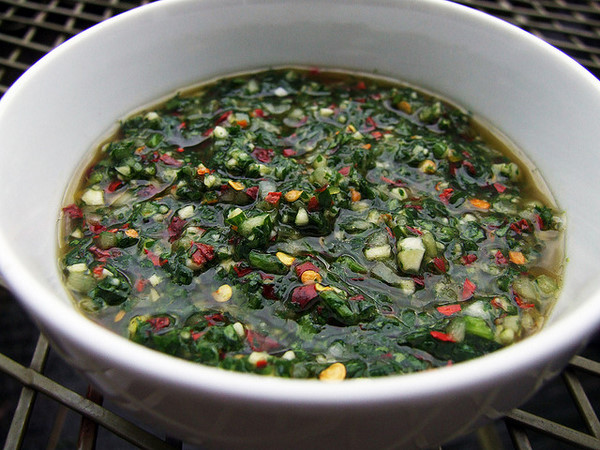
Image courtesy of Food Stories
Contrary to popular belief, this salsa isn’t always a lurid green, nor is it mandatory at Argentine asados. It also doesn’t have to be served fresh – it can last for months in the fridge. Allowing it to sit for a few hours or even a few days will allow the flavour to mellow and the dried herbs to soften, and many people prefer it this way. If you’re interested, you can read more about chimichurri in this excellent post from Asado Argentina.
A word of caution – dried chilli flakes in Argentina are a lot milder than those we get in Australasia. Our chilli flakes are larger and usually include chilli seeds, thus if you are using these kind of chilli flakes, use them sparingly. Chimichurri is not traditionally a hot condiment, sometimes the chilli is omitted altogether but usually it’s added to taste.
Chimichurri
1 cup very finely chopped fresh parsley (use a food processor if you like)
½ a head of garlic, very finely chopped
1 bay leaf, finely chopped
3 Tablespoons of dried oregano
1 teaspoon sweet paprika
½ teaspoon fine salt
Ají molido or dried chilli flakes, to taste
½ cup of oil – olive or grape seed for example, something mild yet suitable for salad
1 cup wine vinegar or apple cider vinegar
½ cup water
Mix all herbs and spices together. Add oil and vinegar, if the chimichurri is too thick; add enough water to thin it out. Add chilli flakes to taste and leave to sit for at least 2 hours.
1. The Presentation of all things Food
Crisp white tablecloths without paper covers. The old-world charm of BA restaurants. And more recently, the beautifully arranged fruit and vegetable stands in every neighbourhood. Although the aesthetic can be homogeneous, there is something lovely about the Porteños’ eye for detail when it comes to food.
2. Cake is sold by weight
In panaderias, smaller cakes, pastries and biscuits from medialunas (small croissants or ‘half moons’) factures to alfajores are often sold by weight rather than quantity. There’s something very decadent about ordering half a kilo of a combination of meringue, dulce de leche and sponge cake to take away.
3. Fresh OJ
Fresh Orange juice is like running water here and not, in the words of Basil Fawlty, ‘rather sticky’. Cafés, restaurants and confiterias all make and serve it, as do some convenience stores and market stalls. It makes that breakfast of coffee and pastry seem a tad more balanced.
4. Garapiñadas
These sugar-coated nuts, usually peanuts or almonds, are cooked and sold by the side of the road in autumn and winter. In the mornings you can see the vendors wheeling their carts to their allocated spots for the day. It’s the kind of snack that is considered gourmet and is expensive where I come from, but here in Buenos Aires a small packet of garapiñadas costs only 2 or 3 pesos (about 50 Aussie cents). Freshly made and with fresh peanuts, they are more addictive than peanut butter. And since peanut butter doesn’t really exist here, they make a tasty substitute.
5. Delivery
One of the most fantastic things about this city, besides most restaurants being open until around 2:00 am is that practically anything you want can be delivered. You want empanadas at midnight? Done. A coffee and a medialuna at 10:00 am? No worries. Most shopfronts have their phone number displayed so that customer can ring up and order what they like. It’s not uncommon to see waiters with a covered tray in hand dodging traffic as they try not to spill coffee for someone a few doors down. There’s no minimum delivery and no delivery charge.
We all know no one wants to hear about other peoples’ holidays, if only because it incites jealousy. But if the success of twitter is anything to go by, EVERYONE wants to read about and see pictures of what people are eating, anytime, anywhere.
With that in mind, even though we’re off to Argentina and Brazil for a month, the Corridor won’t stop kitchening (or something), and rest assured we’ll be eating, cooking, café hopping and eating (definitely gonna be doing at least twice as much eating as anything else) all over the place, Chilean volcanos permitting.
Besos/Beijos,
Lau@corridorkitchen.com and entourage.
About me
 Sharing easy recipes, hunting down the best coffee. Honest accounts, nothing too serious. Read more...
Sharing easy recipes, hunting down the best coffee. Honest accounts, nothing too serious. Read more...Recent Posts
- Aerpress means no more shit #travelcoffee and #workcoffee
- Why I write and four ace bloggers who do it better
- The five best things I ate in London
- Shoreditch is awesome, airports are not
- I quit sugar? Do I bollocks.
- Cubao Street Food, Alexandria
- The Reformatory Caffeine Lab, Surry Hills
- Brewtown Newtown
- Stay caffeinated over Christmas
- Gumption by Coffee Alchemy, Sydney CBD
Popular posts this month…
 Sparkling Long Black posted on May 10, 2011
Sparkling Long Black posted on May 10, 2011  Review – Philips Saeco Intelia posted on January 10, 2012
Review – Philips Saeco Intelia posted on January 10, 2012 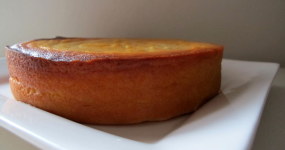 Kosher Whole Orange Cake posted on July 5, 2011
Kosher Whole Orange Cake posted on July 5, 2011  Lemonade Scones and family recipes posted on February 25, 2011
Lemonade Scones and family recipes posted on February 25, 2011  Cheat’s Dulce de Leche posted on January 7, 2011
Cheat’s Dulce de Leche posted on January 7, 2011 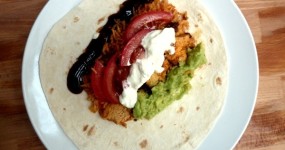 The quest for Mex part 2 – Feisty Chicken Burritos posted on December 21, 2010
The quest for Mex part 2 – Feisty Chicken Burritos posted on December 21, 2010 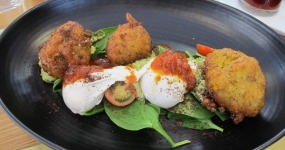 Lau’s Ultimate Corn Fritters and the four fritter truths posted on March 1, 2013
Lau’s Ultimate Corn Fritters and the four fritter truths posted on March 1, 2013  Café Review – Petty Cash Cafe, Marrickville posted on May 31, 2011
Café Review – Petty Cash Cafe, Marrickville posted on May 31, 2011
Disclaimer:
All opinions in this blog are mine, an everyday, real-life person. I do not accept payment for reviews and nor do I write sponsored posts. I do not endorse the content of the comments herein.

